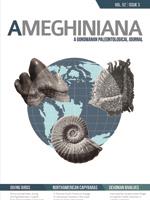Hadrosaurid dinosaurs, the most morphologically derived clade of iguanodontian ornithopods, represent one of the most diverse and widespread clades of Mesozoic vertebrates. Renown for their ‘duck bills’ and bewildering variety of supracranial crests, these large herbivores were an important part of the Late Cretaceous (Santonian—latest Maastrichtian) ecosystems of all continental landmasses except Africa and Australia. This, in combination with their rich fossil record (complete skeletons, thousands of disarticulated skeletal elements, ontogenetic series, eggs, footprints, and soft-tissue impressions), makes hadrosaurids a good model for evolutionary biology studies of extinct terrestrial vertebrates.
“Hadrosaurs” provides numerous examples of such studies, garnering the efforts of an internationally diverse assemblage of 83 authors in shedding light on the taphonomy, biostratigraphy, anatomy, phylogenetic systematics, and functional morphology of hadrosaurids and some of their iguanodontian outgroups. Most of these peer-reviewed contributions were originally presented at the International Hadrosaur Symposium held on September 22–23, 2011 at the Royal Tyrrell Museum of Paleontology, Drumheller, Alberta, Canada.
The book's 36 chapters are appropriately organized in six parts corresponding to major research areas. The first part, “Overview”, features a single chapter by David B. Weishampel, whom the book deservedly honors. He surveys trends in publication rates of several categories of ornithopod studies during the last two centuries. This is followed by two standard alpha taxonomy and phylogenetic systematics sections, full of generally good quality and well-figured osteological descriptions. Of these, “New Insights Into Hadrosaur Origins” provides new data on the ascent of hadrosaurids from basal iguanodontian and hadrosauroid taxa from Europe (Early Cretaceous Wealden iguanodontians), Asia (Equijubus and the new genera Gongpoquansaurus and Plesiohadros) and North America (Cenomanian and Santonian hadrosauroid material from Texas and Alberta, respectively). This section transitions smoothly into “Hadrosaurid Anatomy and Variation”, which deals exclusively with the Campano-Maastrichtian North American record. New data on the skeletal morphology of classics like Edmontosaurus, Gryposaurus, Prosaurolophus, and Hypacrosaurus are provided. In addition, a new genus of Campanian lambeosaurine from Utah, Adelolophus, is also described, along with indeterminate saurolophine materials from Alberta.
The fourth part of the book, “Biostratigraphy and Biogeography”, contains all the volume's contributions on some of the most enigmatic regions of the world regarding hadrosauroid evolution and paleobiology. Particularly welcomed are the chapters reviewing the anatomy, systematics, and diversity of the hadrosauroids (Hadrosauridae and closely related outgroups) from the Late Cretaceous European Archipelago, South America, and southern-most Laramidia (present day Mexico). An interesting addition is the reveal of the premaxilla and premaxillary contribution to the cranial crest of the lambeosaurine Amurosaurus riabinini in a chapter on the hadrosaurids from the Amur Region of Russia. This section of the book ends with two papers documenting the hadrosaurid biostratigraphy of the San Juan Basin (New Mexico, USA) and the Dinosaur Provincial Park (Canada). It is striking that, aside from a brief biogeographical narrative on European hadrosauroids, there are no actual biogeographical studies to be found in this section. In fact, many of the papers do not differ in scope, approach, and type of data from those presented in the “Anatomy and Variation” section.
The next part of the book provides examples of studies on hadrosaurian “Function and Growth”: evidence of divergent developmental pathways in iguanodontians and hadrosaurids, a brief survey of size-frequency distributions of hadrosaurids from the Dinosaur Provincial Park of Alberta (Canada), a study on dental histology and occlusal morphology throughout the ontogeny of the lambeosaurine Hypacrosaurus stebingeri, two studies on hadrosaurian locomotion, and a paper dealing with jaw mechanics and functional morphology of the predentary bone. These chapters highlight some of the approaches, traditional and sophisticated alike, that paleontologists are currently implementing for inferring function and life history in extinct vertebrates.
The last part, “Preservation, Tracks, and Traces”, opens with taphonomical analyses of the paucitaxic Willow Creek Anticline (Two Medicine Formation, Montana) and Princess (Belly River Group, Dinosaur Provincial Park, Alberta) bonebeds. These are followed by an interesting size distribution study of numerous (some uniquely gigantic) specimens of the saurolophine cf. Shantungosaurus from the extensive Kugou Quarry of Zhucheng (Shandong, China). The only chapters devoted to hadrosaurid footprints and pathology are also found in this section. These regard a morphometric analysis of a trackway and the documentation and interpretation of cranial and postcranial osteopathies from Dinosaur Provincial Park specimens, revealing fascinating clues on hadrosaurid behavior. The final three papers of the book provide a timely review and new insights on our current understanding of hadrosaurid integument.
The book closes with an engaging afterword by John R. Horner, in which he outlines some of the findings and conclusions of the book, while pointing out key prevailing gaps in our current understanding of hadrosaurids, such as the need for more specimens from areas like Europe, eastern North America, and South America.
As usually occurs with many entries in the “Life of the Past” series of Indiana University Press, “Hadrosaurs” is neither an introduction nor a synoptic comprehensive source on the state of the art of the subject matter. Rather, it is a compendium of independent studies that, otherwise, could have generally found publication in a peer-reviewed scientific journal. Some of the studies herein presented address specific questions, while others document useful data, often complementing particular aspects of hadrosaurid taphonomy, biostratigraphy, anatomy, taxonomy, diversity, phylogenetics, life history, behavior, and paleoecology. Regardless, the book constitutes a worthy addition to the vast hadrosaurid literature, and will mainly appeal to those that are seriously invested in furthering their knowledge on these animals. The editors and all authors involved are to be commended for their efforts in producing such an scholarly volume containing a wealth of valuable new information on one of the most remarkable evolutionary radiations of Mesozoic terrestrial vertebrates.





